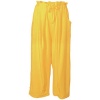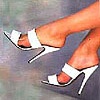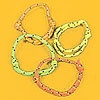There were a lot of fashion trends in the 1980s and 90s that I didn’t subscribe to (puffball skirts, ra-ra skirts, shell suits etc.) but when I found something I liked (stone-washed denim, batwing jumpers, really big hair…) I was a slave to it. Neon socks? Check. Acid house badges? Check. Tracksuit tops with obscure American football stadium logos on? Check.
And there was another one that I was mad about. It was the most exciting thing I’d ever seen, sartorially speaking: a range of clothing that appeared to be one colour but when they experienced a rise in temperature they changed to a completely different hue!
This range began being manufactured by the U.S. firm Generra Sportswear Company, based in Seattle, in 1991. In their native country they were sold under the brand name Generra Hypercolor or Generra Hypergrafix but to us in the UK (and everywhere else) they were known as Global Hypercolor.
The clothes reacted to heat so, for example, a purple t-shirt exposed to hot sunlight would turn a bright pink. A green t-shirt adorning a warm body would create interesting swirly yellow patterns (not unlike the effect you got from tie-dying) where it touched the skin. In my experience however, people who wore one spent most of their time pressing their digits against the fabric for the fun of seeing a contrasting handprint on their torso. And then spending the rest of their day reluctantly allowing everybody else around them to do the same thing.
I say reluctantly, the Global Hypercolor range was actually a perfect excuse for shy and retiring types to get people to touch them (there was even one t-shirt with the phrase ‘Touch Me’ emblazoned on it), even if it was just somebody trying to write fast enough to create a rude word on their back. I’m not saying I did that of course.
The clothes were made using a thermochromic pigment (these are also used in other areas - for example: in children’s toys or babies’ bottles that change colour ) – I’m not going to remotely try and pretend that I understand the science of this but, luckily for Generra, Japanese chemical company Matsui Shikiso did know how it worked. Generra bought the rights across the world to the system that was used to dye cotton fabric with this pigment (it could be used on all natural fabrics apparently, but Generra stuck with cotton) and we all went crazy for their t-shirts.
Wearing the t-shirt for long periods of time, or in hot environments brought about all sorts of interesting effects. You’d see the colour change around the neck and in various creases and folds around the back and the chest. And here lay one of the drawbacks to Global Hypercolor….if you had a – let’s put this delicately, shall we? – perspiration issue then these were perhaps not the best choice of clothing. Nothing more embarrassing than standing in a crowded pub wearing your funky new grey t-shirt, only to go to the toilets a while later and discover that the material under your armpits was a brilliant white. You might have well just stood on the bar and screamed ‘Yes – I’m sweating copiously’ instead.
And Hypercolor jeans. What were they thinking? ‘Hey everybody – check out my glowing crotch!’
The second drawback lay in the longevity of the clothes. Despite reassurances from Generra that the t-shirts would stand up to repeated washes most people discovered that after half a dozen or so whirls in the Hotpoint their lovely purple/pink combo started to splurge into a sort of murky brown which changed to – er – more murky brown when it got hot. You were also in trouble if you weren’t really paying attention to doing the laundry: tumble drying and ironing would permanently ruin the colour changing effect too.
For a while the immense popularity of Global Hypercolor clothing felt like it was taking over the world; they were everywhere you looked. But we were fickle in 1991; the fad actually ended pretty quickly. In 1992 Generra declared bankruptcy, having ploughed enormous amounts of money into buying stock to feed our huge initial demand for Hypercolor products, which peaked and then declined sharply as we all moved on to the next craze. The principal of the company, Steven Miska, blamed the fact that they ‘tried to make too much product available in too short a period of time’ instead of limiting distribution to ‘prolong the life of the product’.
And it seems like our love of colour changing garments really was an early ‘90’s thing. Other companies, including American Apparel and Puma, have attempted to revive the style in the years since Hypercolor left our shelves - even extending into scarves, hoodies and trainers – but it has never really taken off again. Our enthusiasm for the idea of clothes that shows the world you’re sweating seems to have faded as fast as the original t-shirts did.












Do You Remember Global Hypercolor T-Shirts?
Do You Remember Global Hypercolor T-Shirts?